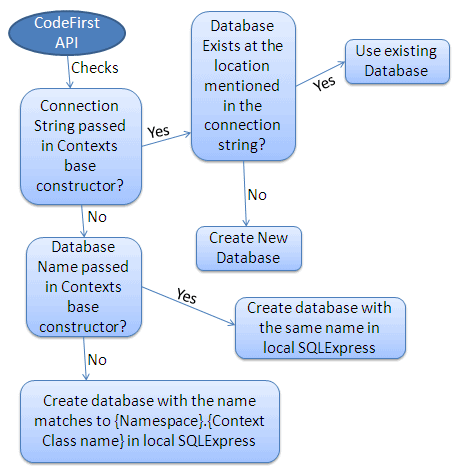Entity Framework Code-First(6):Database Initialization
Database Initialization:
We have seen that Code First creates a database automatically in the Simple Code First Examplesection. Here, we will learn how Code first decides the database name and server while initializing a database.
The following figure shows a database initialization workflow, based on the parameter passed in the base constructor of context class, which is derived from DbContext:
As per the above figure, base constructor of the context class can have the following parameter.
- No Parameter
- Database Name
- Connection String Name
No Parameter:
If you do not specify the parameter in the base constructor of the context class then it creates a database in your local SQLEXPRESS server with a name that matches your {Namespace}.{Context class name}. For example, Code First will create a database named SchoolDataLayer.Context for the following context class:
namespace SchoolDataLayer
{
public class Context: DbContext
{
public Context(): base()
{ }
}
}
Database Name:
You can also specify the database name as a parameter in a base constructor of the context class. If you specify a database name parameter, then Code First creates a database with the name you specified in the base constructor in the local SQLEXPRESS database server. For example, Code First will create a database named MySchoolDB for the following context class.
namespace SchoolDataLayer
{
public class Context: DbContext
{
public Context(): base("MySchoolDB")
{ }
}
}
ConnectionString Name:
You can also define connection string in app.config or web.config and specify connection string name starting with "name=" in the base constructor of the context class. Consider the following example where we pass name=SchoolDBConnectionString parameter in the base constructor.
namespace SchoolDataLayer
{
public class Context: DbContext
{
public SchoolDBContext() : base("name=SchoolDBConnectionString")
{
}
}
}
App.config:
<?xml version="1.0" encoding="utf-8" ?>
<configuration>
<connectionStrings>
<add name="SchoolDBConnectionString"
connectionString="Data Source=.;Initial Catalog=SchoolDB-ByConnectionString;Integrated Security=true"
providerName="System.Data.SqlClient"/>
</connectionStrings>
</configuration>
In the above context class, we specify a connection string name as a parameter. Please note that connection string name should start with "name=" otherwise, it will consider it as a database name. The database name in the connection string in app.config is SchoolDB-ByConnectionString. Code-First will create a new SchoolDB-ByConnectionString database or use existing SchoolDB-ByConnectionString database at local SQL Server. Make sure that you include providerName = "System.Data.SqlClient" in the connection string.
Thus, Code-First use the base constructor parameter to initialize a database.
Entity Framework Code-First(6):Database Initialization的更多相关文章
- Entity Framework Tutorial Basics(13):Database First
Database First development with Entity Framework: We have seen this approach in Create Entity Data M ...
- Entity Framework Code first(转载)
一.Entity Framework Code first(代码优先)使用过程 1.1Entity Framework 代码优先简介 不得不提Entity Framework Code First这个 ...
- Entity Framework Code First (三)Data Annotations
Entity Framework Code First 利用一种被称为约定(Conventions)优于配置(Configuration)的编程模式允许你使用自己的 domain classes 来表 ...
- Entity Framework Code First (二)Custom Conventions
---------------------------------------------------------------------------------------------------- ...
- Entity Framework Code First (一)Conventions
Entity Framework 简言之就是一个ORM(Object-Relational Mapper)框架. Code First 使得你能够通过C#的类来描述一个模型,模型如何被发现/检测就是通 ...
- Entity Framework Tutorial Basics(4):Setup Entity Framework Environment
Setup Entity Framework Environment: Entity Framework 5.0 API was distributed in two places, in NuGet ...
- Entity Framework Tutorial Basics(11):Code First
Code First development with Entity Framework: Entity Framework supports three different development ...
- Entity Framework Code First (七)空间数据类型 Spatial Data Types
声明:本文针对 EF5+, Visual Studio 2012+ 空间数据类型(Spatial Data Types)是在 EF5 中引入的,空间数据类型表现有两种: Geography (地理学上 ...
- Entity Framework Code First (四)Fluent API - 配置属性/类型
上篇博文说过当我们定义的类不能遵循约定(Conventions)的时候,Code First 提供了两种方式来配置你的类:DataAnnotations 和 Fluent API, 本文将关注 Flu ...
- Entity Framework Code First (八)迁移 Migrations
创建初始模型和数据库 在开始使用迁移(Migrations)之前,我们需要一个 Project 和一个 Code First Model, 对于本文将使用典型的 Blog 和 Post 模型 创建一个 ...
随机推荐
- Spark Structured Streaming框架(1)之基本用法
Spark Struntured Streaming是Spark 2.1.0版本后新增加的流计算引擎,本博将通过几篇博文详细介绍这个框架.这篇是介绍Spark Structured Streamin ...
- Java强引用、 软引用、 弱引用、虚引用
Java强引用. 软引用. 弱引用.虚引用 2012-07-09 1.对象的强.软.弱和虚引用 在JDK 1.2以前的版本中,若一个对象不被任何变量引用,那么程序就无法再使用这个对象.也 ...
- C++拷贝构造函数(深拷贝,浅拷贝)
http://www.cnblogs.com/BlueTzar/articles/1223313.html C++拷贝构造函数(深拷贝,浅拷贝) 对于普通类型的对象来说,它们之间的复制是很简单的,例如 ...
- JavaScript 使用技巧(持续更新)
JavaScript 使用技巧(持续更新) 类型检测 使用Object.prototype.toString.call(obj)的方式. 因为无论typeof还是instanceof都无法做到精确判断 ...
- django 实现分页功能
分页效果: 视图代码: # -*- coding: utf-8 -*- from django.shortcuts import render,get_object_or_404 from djang ...
- Ueditor基础使用
感谢大家对我这个菜鸟的帮助,这是我第一次用.NET做网站.在这里向大家推荐个百度免费的文本编辑器Ueditor,是.NET版的,在http://ueditor.baidu.com/website/in ...
- node.js+express+jade系列一:session的使用
此出只介绍内存session的配置好使用 1:打开app.js文件,添加下面红色内容,一定要注意位置在router前面 app.use(express.methodOverride()); sessi ...
- C#实现文件拖放并打开文件(使用ListBox)
1.C#实现文件拖放并打开文件 (http://www.cnblogs.com/GaoHuhu/archive/2012/10/10/2717954.html)
- 理解WCF(第二部分,部分參考他人)
該篇的主題:wcf到底是怎工作的? 一.什么是分布式: 首先看一张图: 由上图对比我们可以发现,区别就是前者把服务器放在了一台电脑上,而后者把服务器放在了多台电脑上.这样多台电脑处理起来的速度比一台电 ...
- js string.format 方法
String.prototype.format = function(args) { var result = this; if (arguments.length > 0) { if (arg ...

